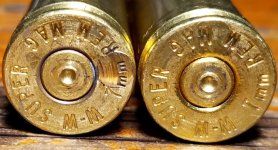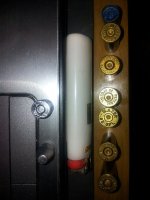Wildernesshunter
New member
I have reloaded for years, but I have to admit, I don't think I have ever witnessed a excessive pressure failure. I have always adhered too.....staying below the maximum CUP numbers. I have a few questions....
1. What are the signs, besides a gun blowing up, of the pressures getting too high for a particular load?
2. We live in a legal/attorney world, so does everyone agree that manufacturers of guns and actions actually build their parts and guns 10% or 25% or 50% stronger than Max CUP?
3. We all know that some of the old rounds that were originally intended for weak actions or were intended for auto-loading have a lower CUP, so as not to blow up a weak actioned gun. But when a round that was handicapped really low, finds itself in a modern day, bolt action rifle.....can those CUP ratings be exceeded?
I ask, because for the first time in my life, I am going to push the envelope. I have a new Howa bolt action 7.62x39. Widely accepted CUP average on this round is 50,000 according to the SPEER Loading Manual. I can get 30 grains of A2200 in the case with a 150gr SP.....which I am guessing will be about a 52-53k CUP.
I have loaded the following.....
28.0 grains (3 rounds) = CUP ????
29.0 grains (5 rounds) = CUP 48,698
29.5 grains (5 rounds) = CUP ????
30.0 grains (3 rounds) = CUP ????
That first 30 grain load....I may pull the trigger with a string.
I expect for some of you to give me the standard......you're bat-CENSORED- crazy....which is fine, but I would like some intelligent responses and any experience you have had.
........
1. What are the signs, besides a gun blowing up, of the pressures getting too high for a particular load?
2. We live in a legal/attorney world, so does everyone agree that manufacturers of guns and actions actually build their parts and guns 10% or 25% or 50% stronger than Max CUP?
3. We all know that some of the old rounds that were originally intended for weak actions or were intended for auto-loading have a lower CUP, so as not to blow up a weak actioned gun. But when a round that was handicapped really low, finds itself in a modern day, bolt action rifle.....can those CUP ratings be exceeded?
I ask, because for the first time in my life, I am going to push the envelope. I have a new Howa bolt action 7.62x39. Widely accepted CUP average on this round is 50,000 according to the SPEER Loading Manual. I can get 30 grains of A2200 in the case with a 150gr SP.....which I am guessing will be about a 52-53k CUP.
I have loaded the following.....
28.0 grains (3 rounds) = CUP ????
29.0 grains (5 rounds) = CUP 48,698
29.5 grains (5 rounds) = CUP ????
30.0 grains (3 rounds) = CUP ????
That first 30 grain load....I may pull the trigger with a string.
I expect for some of you to give me the standard......you're bat-CENSORED- crazy....which is fine, but I would like some intelligent responses and any experience you have had.
........


